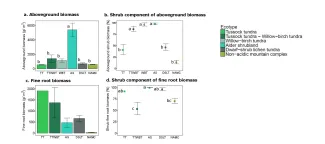High-latitude ecosystems are made up of a mosaic of different plant communities, all of which are exposed to warming at a rate double that observed in ecosystems at lower latitudes. Losses of C from thawing and decomposing permafrost may be offset by increased plant productivity, but plant allocation to belowground structures and acquisition of limiting nutrients remain key sources of uncertainty in these ecosystems. The relationship between belowground plant traits and environmental conditions is not well understood, nor are tradeoffs between above- and belowground plant traits. To address these knowledge gaps, we sampled above- and belowground plant tissues from six different ecotypes along the Kougarok hillslope on the Seward Peninsula, Alaska. Destructive harvests determined aboveground biomass pools for these ecotypes range from 520 g/m2 to 6330 g/m2 and shrubs make up 10-99% of the aboveground biomass pool (Figure a&b). Belowground fine-root biomass and root distributions were measured by sorting shrub and graminoid fine roots from soil cores collected in 2016. Initial findings indicate fine root biomass (Figure c) and depth profiles vary widely across these ecotypes. Non-acidic mountain complex and Alder shrubland soil profiles were rocky with fine roots located from 0-10 cm while tussock tundra and tussock tundra- willow birch tundra sites had approximately half the fine root pool located below 20 cm. The ratio of fine root biomass to aboveground biomass ranged from 0.03 in the Alder shrubland ecotype to 10 in tussock tundra. The shrub component of fine root pool did not reflect the contribution of shrubs to the aboveground biomass pool (Figure b&d). By identifying key sources of variation in above and belowground plant traits, this research lays important groundwork for incorporating belowground plant dynamics into earth system models.
For more information, please contact:
Verity Salmon
salmonvg@ornl.gov

